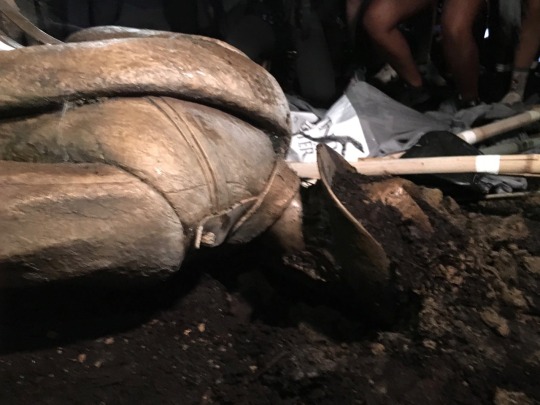By Mike Ogle
Mary Anngady was a girl the last time the Confederacy lost Chapel Hill. She lived in quarters behind the Davis house with a dozen enslaved people, including her mother and four brothers. Franklin Davis, owner of so much, ran a small-town general store. In the main house, Bettie Davis and her children drilled Mary on “courtesy and respect” for her “superiors.” Many days, Mary would “scrap” with her brother over who got to rub Bettie’s feet. Mary hoped to be allowed to sleep at those feet at night.
Mary recalled much from her childhood for the “Slave Narratives” collected by the Federal Writers’ Project in the 1930s. She also remembered well the moment she learned she was free. “The first I knew of the Yankees was when I was out in my marster’s yard picking up chips and they came along, took my little brother and put him on a horse’s back and carried him up town,” she said. “I ran and told my mother about it. They rode brother over the town a while, having fun out of him, then they brought him back. Brother said he had a good ride… .” The Union soldiers took food from Franklin’s store and gave Mary’s father, James Mason, owned by another family, some crackers and meat. James chastised them for stealing. Mary later went to college.
White families passed down for generations melancholy tales from that period here starting when Union soldiers rode into town on Easter in 1865. Meanwhile, the stories of people like Mary were broadly ignored. That whitewashing occurred despite the fact that 4 in 10 Chapel Hillians were enslaved around the start of the Civil War, and about half the town was black, according to Yonni Chapman’s doctoral dissertation, “Black Freedom and the University of North Carolina, 1793-1860.”
The appearance of those blue uniforms coming uphill on a dirt road symbolized a lot more than the loss of a war. Those soldiers’ arrival meant the hierarchy that was the Confederacy’s “cornerstone”—as its vice president called it—was eroding. In 2018, the Confederacy has been riding back into Chapel Hill. Its modern supporters are also upset over something lost: Silent Sam. But the Confederate statue had always signified something much more than lives lost at battle. Like those Federal troops, Silent Sam was a symbol of the lives its admirers had lost ownership of and still aimed to control.
Until the war was lost, UNC, America’s oldest public university, had been a place for educating and strengthening the slaveholding class. By 1860, North Carolina’s legislature had a higher percentage (85) of politicians owning human beings than any statehouse in the country, according to Many Excellent People: Power and Privilege in North Carolina, 1850-1900. So many of the college town’s white men volunteered for the local infantry that within weeks of the war’s start only a few dozen able-bodied ones remained. So many UNC students immediately traded books for rifles that UNC’s president, David L. Swain, wrote begging that North Carolina’s elite sons complete their coursework and contribute to the cause in other ways.
In a well-worn story from shortly after the war’s end, the Federal general occupying Chapel Hill married the college president’s daughter. White Chapel Hillians were said to have spit on invitations, and students hanged Swain and his new son-in-law in effigy. It was in this environment that Julian Carr “horse-whipped a Negro wench,” as he bragged at Silent Sam’s 1913 dedication.
African Americans sent a lovely cake for the wedding, but Swain didn’t let the Yankee addition to his family weaken his allegiance to white supremacy. He had owned 32 enslaved people before the war, and when occupying Union forces banned whipping after it, Swain and two UNC trustees went to ask the U.S. president to reinstate legal beatings.
Before emancipation, Nellie Strayhorn’s owner once whipped her for biting an apple too fresh off the tree. Nellie was 14 when the war ended, and while enslaved on Wesley and Julie Atwater’s farm, she’d “ploughed same as a man,” Nellie recalled years later. Wesley joined the Confederate Army, and Nellie’s mother was made to cook barrels of food for troops fighting to keep her family as chattel.
Nellie’s words were reprinted in a book commemorating Chapel Hill’s 1993 bicentennial titled Chapel Hill: 200 Years “Close to Magic.” Her story appeared under a section called “Reminisces of Slavery Days.” Nearly 80 years after those days, like Mary Anngady, Nellie had also vividly remembered in her original interview the moment she gained freedom. She had been laboring with her mother when Union soldiers approached. “… All the hands was in the field, just like Master was there,” Nellie said. “Dey asked Mother if she knew we was free. She said, ‘No, Sir,’ and I was standin’ beside her when she said it. ‘We fought to free you,’ dey told her.”
With that new freedom, formerly enslaved people all over the South, Chapel Hill included, searched for loved ones lost on the auction block. Yet generations of white Chapel Hillians mournfully remembered this era for having been pulled down off their pedestal.
Bitterness over the demotion eventually led UNC to close for four years, and Cornelia Phillips Spencer paved the way for its reopening under leaders of shared Confederate values. To celebrate the triumph, Spencer rang the college bell students had tolled while hanging the father of the bride in effigy. “The whole framework of our social system is dissolved,” she’d written in her diary after the Union arrived. “The negroes are free… .”
Mike Ogle is a journalist who lives near Pine Knolls.


Georgia Bradsher
Just read the account of Nellie Strayh.orn. She was my great grandmother.